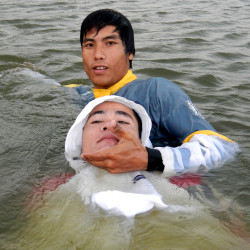Rescues: Your Safety First
The key for a successful rescue is to stay out of danger. Your safety is of utmost importance and always comes first.
Whatever you do, avoid putting yourself in danger. There is no need to add yourself to the casualty list.
Regular Training
Good rescue skills enable you to perform an effective rescue and live to tell the story.
Assess your abilities in regular intervals.
Keep practising in open water or swimming pools under realistic conditions.
This keeps you up to speed and alert.
Think Before You Act
Before you jump in and go for a casualty, assess the situation, the condition of the casualty and whether it is safe to approach the casualty directly or if you need to call for backup assistance. Only enter the water if you have no alternative and can do so safely. You may also need to communicate with other lifeguards or emergency responders to coordinate their efforts and ensure that everyone involved in the rescue is working together effectively.
Once you have determined the best course of action, you will approach the casualties slowly and carefully, taking care not to startle them or cause further distress. You could use a variety of techniques such as swimming alongside them, using a throw rope or clothing to pull them onto a nearby boat or shore.

Approach the casualty.
Perform a rescue.

His arm should be loose for an extended arm tow.
Reach - Throw - Row - Go - Tow
This over 100-year-old mnemonic of selecting the most appropriate rescue technique remains the gold standard.
The rescue categories are arranged by degree of risk and degree of difficulty. The swimming rescue with no form of equipment and towing with direct physical contact must be the last resort. It should thus be a very rare occurrence.
However, over half of trained lifeguards and water safety instructors had engaged in a body contact rescue. This is more than expected as all were trained not to use direct body contact towing, if at all possible. Even more surprising was that for a third of these, this was their first ever swimming rescue.
This highlights the importance of regular skills training with a focus on managing the escalation of engagement.
So get your kit on, head for a pool or the beach and practice the rescue priorities.
Let's see who stays dry the longest.
Rescue Priorities
Some types of rescues are safer than others. Escalate your involvement only as far as necessary. Start with land based rescues. If the first is unsuccessful (or impossible), try the next one on the list. Only as a last resort use a rescue tow.
-
Land Based Rescues
- Shout
- Signal
- Reach
- Throw
-
Water Rescues
- Wade
- Row
- Swim with Aid
- Swim without Aid
Rescue Towing
When all other attempts to get the casualties out have failed, then you may have to go in and and get them. Only as a last resort should you enter the water and tow a casualty back to safety. Enter the water safely, you may not know the conditions.
There are many different tows. Some have regional variations. The correct rescue tow depends on the casualty. Discuss and practice the main rescue tows with your class. Compare results and work out which tow works best for a given casualty.
Always keep the casualty's face out of the water. Some towing techniques extend their airway for better breathing, but it can also let water in if you're not careful. Do not push against the throat, or your casualty can't breathe.
Towing Aid
Remember that any clothing you wear can be used as a towing aid.
That is one of the reasons we always swim in clothes.
We're ready. We're prepared. Are you?